 |
 |
 |
Our route - I:
28.10.03:
Amritsar
29.10.03:
Pathankot
30.10.03 - 31.10.03:
Dharamsala
01.11.03 - 03.11.03:
Rewalsar
04.11.03:
Mandi
05.11.03 - 07.11.03:
Manali
08.11.03:
Mandi
09.11.03 - 11.11.03:
Shimla
Naldhera
12.11.03 - 17.11.03:
Delhi
18.11.03:
Neemrana
19.11.03 - 21.11.03:
Jaipur
Amber
22.11.03 - 25.11.03:
Pushkar
26.11.03:
Ajmer
27.11.03 - 28.11.03:
Jodhpur
29.11.03:
Ranakpur
30.11.03 - 02.12.03:
Udaipur
03.12.03 - 07.12.03:
to Goa
08.12.03:
Panjim/Panaji
09.12.03 - 14.12.03:
Mandrem
14.12.03 - 15.12.03:
Candolim
Panjim/Panaji
16.12.03 - 04.01.04:
Agonda
05.01.04 - 06.01.04:
Panjim/Old Goa
07.01.04 - 12.01.04:
Hampi
13.01.04 - 14.01.04:
Bijapur
15.01.04 - 17.01.04:
Ellora
18.01.04 - 20.01.04:
Ajanta
21.01.04 - 22.01.04:
Indore
23.01.04 - 24.01.04:
Orchha
25.01.04 - 28.01.04:
Khajuraho
29.01.04:
Chitrakut
30.01.04 - 05.02.04:
Varanasi
Our route - II:
03.04.04:
Banbassa
04.04.04 - 06.04.04:
Delhi
07.04.04 - 08.04.04:
Amritsar
|
|
|
 |
| India |
 |
 |
 |
 |
 |
 |
On this page, we (will) describe our experiences in India.
Apart from the travelogue for this country
you will also find a number of links to useful sites,
ranging from general information to embassy homepages.
Content:
Part 1: North-west India (28.10.03 - 24.12.03)
Part 2: Central India (25.12.03 - 14.02.04)
Part 1: North-west India (28.10.03 - 24.12.03)
Written by: Dorrit
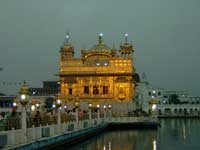 Crossing the border took all morning and was a very hungry matter, since Ramadan had started in Pakistan and we couldn't get any breakfast there anymore. India still looks a lot like Pakistan here: water buffaloes walk in the fields or lie in the water, dusty chaotic villages are full of people, little shops and all kinds of vehicles. A big difference are the many women we suddenly see in the streets and the brightly coloured sari's they are wearing. Here, women are allowed to cycle, ride a scooter or drive a car again and do so massively. Men are no longer wearing wide baggy suits, but walk around in western clothes.
Crossing the border took all morning and was a very hungry matter, since Ramadan had started in Pakistan and we couldn't get any breakfast there anymore. India still looks a lot like Pakistan here: water buffaloes walk in the fields or lie in the water, dusty chaotic villages are full of people, little shops and all kinds of vehicles. A big difference are the many women we suddenly see in the streets and the brightly coloured sari's they are wearing. Here, women are allowed to cycle, ride a scooter or drive a car again and do so massively. Men are no longer wearing wide baggy suits, but walk around in western clothes.
In the Indian part of Punjab the majority of the population are Sikh people (the Sikh religion is roughly speaking a mix of Hinduism and Islam, according to our travel guide), who can be recognized by the brightly coloured turbans and the long hair and beards they are not allowed to cut.
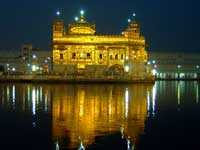 In Amritsar we saw the first cows in the streets, grazing the heaps of rubbish that lie at the roadside. They are accompanied by entire herds of wild pig. We took the cycle-rickshaw to the centre and died a thousand deaths in the chaotic traffic there. The driver was too stoned to get scared anymore and started a conversation about the good sides of smoking "ganji" as hashish are called here. We managed to arrive safely and visited the golden temple, the most important holy site of the Sikhs. Stately white palaces with onion-shaped domes are forming a square around an artificial lake, in which middle lies the amazingly beautiful golden temple. The outer walls are "only" covered with brass, but the roof is tiled with real gold. A marble landing of some 60 metres long takes the pilgrims to the temple, where the holy book of the Sikhs is being kept. At the entrance we had to wait, because the pilgrims all wanted to kneel down and kiss the threshold. We decided to skip that part. Men with long white beards were singing verses from the holy book while the pilgrims shuffled by. Outside, an Indian family wanted to take a picture with us, not the last time in India this happened to us: the next day another Indian even took us to an official photo studio. We feel like the king and queen here.
In Amritsar we saw the first cows in the streets, grazing the heaps of rubbish that lie at the roadside. They are accompanied by entire herds of wild pig. We took the cycle-rickshaw to the centre and died a thousand deaths in the chaotic traffic there. The driver was too stoned to get scared anymore and started a conversation about the good sides of smoking "ganji" as hashish are called here. We managed to arrive safely and visited the golden temple, the most important holy site of the Sikhs. Stately white palaces with onion-shaped domes are forming a square around an artificial lake, in which middle lies the amazingly beautiful golden temple. The outer walls are "only" covered with brass, but the roof is tiled with real gold. A marble landing of some 60 metres long takes the pilgrims to the temple, where the holy book of the Sikhs is being kept. At the entrance we had to wait, because the pilgrims all wanted to kneel down and kiss the threshold. We decided to skip that part. Men with long white beards were singing verses from the holy book while the pilgrims shuffled by. Outside, an Indian family wanted to take a picture with us, not the last time in India this happened to us: the next day another Indian even took us to an official photo studio. We feel like the king and queen here.
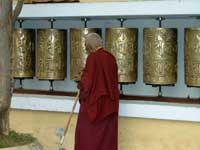 The road to Dharamsala, where the Dalai Lama lives, took us through some lovely green hills with banana trees, brightly coloured flowers and wild monkeys at the roadside. Slowly the hills made way for the Himalayan range, in the background we started seeing the first snow caps. The last 20 km to Dharamsala rise 2000 metres on a steep and narrow winding road. In McLeodGanj, where the monastery is situated, loads of long time India travellers with dreadlocks are hanging around, trying to find themselves while smoking one joint after the other. Lepers without fingers or sometimes even without hands or arms go round and beg for money or food. We took a quick look at the monastery, which is very new (1989) and very empty. The Dalai Lama was not at home, but we saw many bald-shaven Tibetan monks in red and yellow garments. The murals inside the monastery are true masterpieces in miniature painting, showing Chinese dragons, Gods and Buddha's in beautiful colours worked out to the last tiny detail.
The road to Dharamsala, where the Dalai Lama lives, took us through some lovely green hills with banana trees, brightly coloured flowers and wild monkeys at the roadside. Slowly the hills made way for the Himalayan range, in the background we started seeing the first snow caps. The last 20 km to Dharamsala rise 2000 metres on a steep and narrow winding road. In McLeodGanj, where the monastery is situated, loads of long time India travellers with dreadlocks are hanging around, trying to find themselves while smoking one joint after the other. Lepers without fingers or sometimes even without hands or arms go round and beg for money or food. We took a quick look at the monastery, which is very new (1989) and very empty. The Dalai Lama was not at home, but we saw many bald-shaven Tibetan monks in red and yellow garments. The murals inside the monastery are true masterpieces in miniature painting, showing Chinese dragons, Gods and Buddha's in beautiful colours worked out to the last tiny detail.
Before we left, we also had a look at a British colonial church, the "St. John in the wilderness Church", which says enough about how the British viewed the Indians back then...
In this area (Himachal Pradesh) the roads are very narrow, the bends very sharp and the bus drivers very suicidal. We had to drive very carefully and were happy when we had covered 70 km after a 7 hour drive. But the scenery is fabulous and you just don't get bored here. We passed alpine pine forests, terraced fields where oxen were pulling hand ploughs, women in brightly coloured sari's were working on the road under a sign saying "men at work" - carrying bags of sand or piles of stones seems to be a woman's job here - and colourful little shops in little mountain villages. We passed a Swiss couple, Urs and Denise, that cycled all the way from Switzerland to here and were planning to drive on to Delhi. We both had heard about each other from other travellers a couple of times, so it was very nice to meet at last!
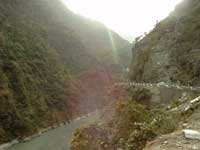 In the tiny mountain village Rewalsar a Hindi temple, a Sikh temple and a Buddhist monastery are peacefully lying next to each other around a holy crater lake. We parked the car at the Sikh temple here and after taking the dogs for a walk we wanted to get something to eat. Since we thought it would be a bit hard on the dogs to put them in the car again after a whole day of driving, we tied them to the bumper so they could play outside. When we returned after 15 minutes all we found was Shimal and an empty leash. Immediately, we started searching the entire village and asked the villagers if they had seen Junub. Eventually a man told us he saw a 13 year old boy getting in a taxi with our dog. But of course nobody we asked knew which taxi or in which direction it went. So we drove along every road that leads from Rewalsar, but no sign of Junub.
To make things worse, Shimal was attacked by a street dog during another search of the village the next day and had to be stitched by the vet. Two kind Danes who drove here from Denmark with the same car as we have (a VW LT) and who have settled down in Rewalsar invited us for dinner and promised to keep a lookout for Junub. The chance that the boy will show up anywhere near the village with the dog is very small though.. After two days of searching we had to acknowledge that it was no use to search any longer and left Rewalsar with pain in our hearts.
In the tiny mountain village Rewalsar a Hindi temple, a Sikh temple and a Buddhist monastery are peacefully lying next to each other around a holy crater lake. We parked the car at the Sikh temple here and after taking the dogs for a walk we wanted to get something to eat. Since we thought it would be a bit hard on the dogs to put them in the car again after a whole day of driving, we tied them to the bumper so they could play outside. When we returned after 15 minutes all we found was Shimal and an empty leash. Immediately, we started searching the entire village and asked the villagers if they had seen Junub. Eventually a man told us he saw a 13 year old boy getting in a taxi with our dog. But of course nobody we asked knew which taxi or in which direction it went. So we drove along every road that leads from Rewalsar, but no sign of Junub.
To make things worse, Shimal was attacked by a street dog during another search of the village the next day and had to be stitched by the vet. Two kind Danes who drove here from Denmark with the same car as we have (a VW LT) and who have settled down in Rewalsar invited us for dinner and promised to keep a lookout for Junub. The chance that the boy will show up anywhere near the village with the dog is very small though.. After two days of searching we had to acknowledge that it was no use to search any longer and left Rewalsar with pain in our hearts.
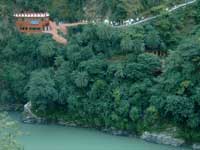 We returned to Mandi and spent the night near the southern end of the Kulu valley. A beautiful trip, but we could not really enjoy it.
We returned to Mandi and spent the night near the southern end of the Kulu valley. A beautiful trip, but we could not really enjoy it.
The Kulu valley is gorgeous; a narrow canyon, overgrown with palm trees and other exotic plants on both sides of the river Kulu. Further north the overgrowth looks more like we know in Northern-Europe; oak trees in autumn colours grow near the riverside, above it dark green pine woods and behind that the snow-capped mountain peaks. At the northern end of the valley lies Manali, a grimy village full of grey concrete hotels that does not exactly grace its surroundings. At the border of the village "live" the untouchables or casteless. The poor souls were sitting sparsely clad around a little fire in front of their huts made of plastic, wood and waste and were trying to keep warm when the outside temperature plunged from 25°C in the afternoon to near zero in the evening. Most of their huts are in the river bed at the side of the water, since these people are not allowed to live in the village or use the communal water pump. Officially the caste system is banned in India, but here it appears to be still very much alive. I plundered our wardrobe and put everything we don't really need in a big bag, which we gave to a little mother in front of one of the huts the next day. At one of the other huts there was a nest with puppies. We thought that if we wanted Shimal to get used to another dog, we would have to be quick, so we picked a female that we gave the original name of Manali. The "owners" were very happy that they did not have to put the animal on the street and thanked us many times for taking it.
 On the highway to Delhi there were a lot of traffic participants we do not have in Europe: we passed groups of monkeys, an Indian on an elephant, camel carts, an Indian on a scooter carrying a bunch of 2,5 metre (!) steel cables on his shoulder... everything seems to be allowed here. Our first impression of Delhi was not the best: left of us a black river - the black is supposedly from the bleaching of cloth - that smelt of open canalisation and chemicals. Right of us some dilapidated concrete flats, below them muddy shores around a stinking pool with bright green alga. Mangy stray dogs and enormous wild pigs were roaming between the little slum huts in the mud. Children that looked as if they haven't had a wash in their entire life went from car to car and begged. These are obviously the poorest quarters of Delhi. When we drove on, the city became continuously richer, greener and especially cleaner. In the entire city however, we kept having irritated eyes, nose and throat from the thick bluish fog that was caused by the exhaust fumes. There are over 2 million cars in Delhi! Every single street seems to be filled up to the brim with traffic, cows walk between the cars and beggars knock on your window as soon as you slow down. In Delhi there are supposed to be 3 tourist camp sites, and it cost us an entire day and a year of our lives to work our way from one closed campsite to the other. We did not find a single camp site that was still open.
On the highway to Delhi there were a lot of traffic participants we do not have in Europe: we passed groups of monkeys, an Indian on an elephant, camel carts, an Indian on a scooter carrying a bunch of 2,5 metre (!) steel cables on his shoulder... everything seems to be allowed here. Our first impression of Delhi was not the best: left of us a black river - the black is supposedly from the bleaching of cloth - that smelt of open canalisation and chemicals. Right of us some dilapidated concrete flats, below them muddy shores around a stinking pool with bright green alga. Mangy stray dogs and enormous wild pigs were roaming between the little slum huts in the mud. Children that looked as if they haven't had a wash in their entire life went from car to car and begged. These are obviously the poorest quarters of Delhi. When we drove on, the city became continuously richer, greener and especially cleaner. In the entire city however, we kept having irritated eyes, nose and throat from the thick bluish fog that was caused by the exhaust fumes. There are over 2 million cars in Delhi! Every single street seems to be filled up to the brim with traffic, cows walk between the cars and beggars knock on your window as soon as you slow down. In Delhi there are supposed to be 3 tourist camp sites, and it cost us an entire day and a year of our lives to work our way from one closed campsite to the other. We did not find a single camp site that was still open.
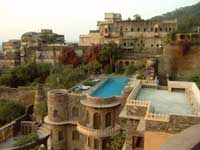 Eventually we gave up and drove to the diplomat area in New Delhi where Panca and Seth, two friends of Roel, live. We felt a bit awkward to arrive there 2 days before Roos and Roel (Coen's sister and brother in law) got here, but we were really wasted after a whole day of driving in Delhi. However, they gave us a very warm welcome and we spent the rest of the evening drinking beer together.
Eventually we gave up and drove to the diplomat area in New Delhi where Panca and Seth, two friends of Roel, live. We felt a bit awkward to arrive there 2 days before Roos and Roel (Coen's sister and brother in law) got here, but we were really wasted after a whole day of driving in Delhi. However, they gave us a very warm welcome and we spent the rest of the evening drinking beer together.
The following two days we took a rickshaw to the centre and had a look at Delhi. The city is a lot nicer if you do not have to drive in it yourself! Panca took us to some Dutch friends of hers to watch a football match (Holland-Scotland) and suddenly we found ourselves in a very Dutch house eating Dutch food, drinking Heineken and watching Dutch football in the middle of Delhi. At 10:30 pm Roos and Roel arrived at the airport and we spent half the night exchanging the latest news about each other and the family.
With them we visited the old centre of Delhi, had a cycle-rickshaw drive us through the narrow old bazaar streets and watched the teeming masses at the Sunday market. Here you can even have your ears cleaned: we watched how one man was digging out another man's ear with a small spoon. Brr.
Of the many attractions Delhi has to offer we can really recommend - apart from the Red Fort - the Friday mosque and the Humayun's tomb, that formed the inspiration for the Taj Mahal.
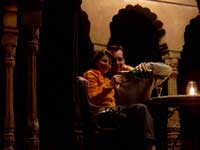 On the way from Delhi to Jaipur we spent the night in the small village Neemrana, where a fabulous Maharaja-fort in Moghul style dominates the village. The fort with its numerous bay windows, little towers, patio's and wood-carved balconies has been turned into a luxury hotel with marble swimming pool, sauna and restaurant. A very romantic spot to propose, and that is exactly what Roel did. Roos said yes and they plan to get married in August next year. Hurray!
On the way from Delhi to Jaipur we spent the night in the small village Neemrana, where a fabulous Maharaja-fort in Moghul style dominates the village. The fort with its numerous bay windows, little towers, patio's and wood-carved balconies has been turned into a luxury hotel with marble swimming pool, sauna and restaurant. A very romantic spot to propose, and that is exactly what Roel did. Roos said yes and they plan to get married in August next year. Hurray!
The "pink city" of India, Jaipur, has got this name because the entire old city centre is made of pink sand stone. The most famous building of Jaipur is no doubt the Palace of the Winds, a high facade with 125 small windows, through which the ladies of the court could see the parades on the streets below without being seen themselves. When you stand in front of it, it looks like a real palace, but when you walk around it you see that it is no more than a facade, with nothing behind it! Less famous, but at least as beautiful is the city palace of Jaipur, a part of which is still inhabited by the Maharaja-family. The other part is accessible to the public and contains lovely little buildings in marble filigree, the biggest silver vases in the world (the Maharaja used them on a trip to London to bring Ganges water, because he did not trust the English water) and marvellous murals. From the city palace, we walked back to hotel via the crowded bazaar and bought some souvenirs. Outside on the street camel carts rolled by and we saw beautifully painted elephants.
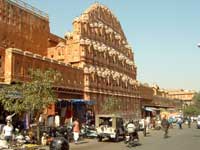 On the pavement beside that snake charmers sat behind little cobra's in a basket.
On the pavement beside that snake charmers sat behind little cobra's in a basket.
Here in Jaipur we also went to the cinema to see a real Bollywood-production. The film studio's in Bombay make more films that those in Hollywood and their films are very popular in India. The film was in Hindi and did not have subtitling, but the story was so simple that we understood and enjoyed it anyway.
Near Jaipur we visited one of the biggest forts of the region Rajasthan, in Amber. The four of us climbed on an elephant to be taken up to the fort. A very nice experience, until I saw that the animal was spurred on with a fishing hook and that his ears were already bleeding.
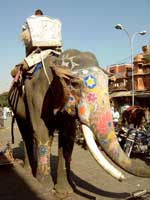 Next stop was Pushkar, where the biggest camel fair in India is held every year. Unfortunately the fair had just ended, so all we saw of it was the enormous piles of rubbish that were left behind. Although Pushkar is only a very small village, there are over 400 temples around a holy lake. Around the lake are big stairs called "ghats", where the pilgrims can take a wash. We took a three hour "sunrise camel ride" through the desert. Getting on and off the animal is a little bit difficult - it is just like a big accordion that is being folded - but once you are on it, it is just like horse riding on a very high horse with a very long neck. In the middle of the desert we stopped to watch the sun rise over the sand dunes, then we rode on through some fabulous steppe landscape back to the village. The dry grass is being enlivened by enormous trees full of lianas and monkeys. At one point we scared a herd of grazing emus, that ran off in front of our camels.
Next stop was Pushkar, where the biggest camel fair in India is held every year. Unfortunately the fair had just ended, so all we saw of it was the enormous piles of rubbish that were left behind. Although Pushkar is only a very small village, there are over 400 temples around a holy lake. Around the lake are big stairs called "ghats", where the pilgrims can take a wash. We took a three hour "sunrise camel ride" through the desert. Getting on and off the animal is a little bit difficult - it is just like a big accordion that is being folded - but once you are on it, it is just like horse riding on a very high horse with a very long neck. In the middle of the desert we stopped to watch the sun rise over the sand dunes, then we rode on through some fabulous steppe landscape back to the village. The dry grass is being enlivened by enormous trees full of lianas and monkeys. At one point we scared a herd of grazing emus, that ran off in front of our camels.
The last day with Roos and Roel was spent at the pool side in a luxurious hotel, a nice and relaxing day. In Ajmer we waved them off at the train station; they took the train back to Delhi and from there the plane back home. We really enjoyed those two weeks with them!
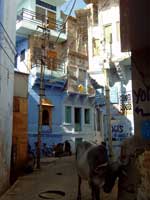 Jodhpur is called the "blue city" of India, since all houses in the centre are painted blue. Originally blue was the colour of the highest caste, the Brahmans, that painted their houses blue as a status symbol. By now however, nearly all houses in the old centre are painted blue, a fantastic sight from the fort on the hill. The people look fabulous in brightly coloured sari's and turbans. Most women have enormous nose rings that is connected to their ear ring by a golden chain. Several people tried to touch us, one woman squeezed my arm, gave a little shriek and ran away. Later she came back and did the same to Coen. Strange. Many people stared at us, although we can hardly have been the first tourists there.
Jodhpur is called the "blue city" of India, since all houses in the centre are painted blue. Originally blue was the colour of the highest caste, the Brahmans, that painted their houses blue as a status symbol. By now however, nearly all houses in the old centre are painted blue, a fantastic sight from the fort on the hill. The people look fabulous in brightly coloured sari's and turbans. Most women have enormous nose rings that is connected to their ear ring by a golden chain. Several people tried to touch us, one woman squeezed my arm, gave a little shriek and ran away. Later she came back and did the same to Coen. Strange. Many people stared at us, although we can hardly have been the first tourists there.
Just like in other cities in India we saw a lot of poverty here: at night the pavement is full of homeless that haven't got enough money to have a home in the slums, and meagre, dirty children swarm around you for money.
Such a sad sight.
In Ranakpur we went to see the Jain temples. Jainism is a split off from Hinduism and roughly said comparable to Buddhism. All life is sacred and thus the monks wear mouth covers to avoid accidentally swallowing an insect and carry a broom stick to sweep the road in front of them so they won't accidentally step on an ant. From outside their temples look just like Hindu-temples, but the interior is covered entirely in marble filigree. Apart from the golden temple in Amritsar the most beautiful edifice I have seen so far in India. Innumerable figures are carved into the marble walls, every centimetre of the interior is covered with these detailed pieces of art.
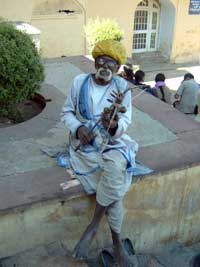 Udaipur was the last city in Rajasthan we visited. Our main goal here was the city palace, but although we stayed 2 days we never made it there. Partly because the rest of the city was too nice to rush through, partly because we are quite satiated with forts and palaces in Rajasthan. At night we had a romantic candle-light dinner in the garden of the Ambrai restaurant, which offers a great view over the lake and the splendidly lit city palace. A part of the James Bond film Octopussy has been filmed here and every single hotel and restaurant has this film running permanently it seems.
Udaipur was the last city in Rajasthan we visited. Our main goal here was the city palace, but although we stayed 2 days we never made it there. Partly because the rest of the city was too nice to rush through, partly because we are quite satiated with forts and palaces in Rajasthan. At night we had a romantic candle-light dinner in the garden of the Ambrai restaurant, which offers a great view over the lake and the splendidly lit city palace. A part of the James Bond film Octopussy has been filmed here and every single hotel and restaurant has this film running permanently it seems.
From Udaipur we drove the entire stretch to Goa in one piece, a horrible 5 day drive at 8 hours driving a day. Apart from the betel chewing truck drivers that all seemed to be after our lives the trip was mainly boring and hot. Since the first 600 (!) km were under construction, we spent a lot of time standing in traffic jams or driving only very slowly. From the second day on the road Manali fell ill, she wouldn't eat anymore, threw up and had diarrhoea. No matter what we tried to feed her, she turned away from it disgustedly. When we finally reached the first Goan beach the next evening she even shat blood. We rushed to Goa's capital Panjim (also known as Panaji) and went to the vet, who sacrificed half his free Sunday night for us. He put her on a drip and told us she was suffering from parvo virus. This disease (you cannot vaccinate against it before the dog is 3 months old, which she isn't) is lethal and resistant against all known antibiotics. The vet however, claimed to have saved more than one dog from it and thus we went to him daily to get her drip for the whole following week. As parvo virus is very contagious, Shimal started suffering from it too, so he too had to get a daily drip. Manali was only a shadow of what she used to be and more than once we thought her last hour had come. But the vet was right and after one week of drips, beach and healthy sea air they slowly started recovering!
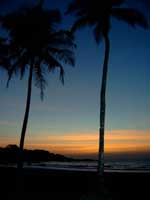 Goa is gorgeous with its jungle, coconut palm fields, blue rivers, tiny wooden fishing boats and especially its clean beaches at the Arabian sea.
Goa is gorgeous with its jungle, coconut palm fields, blue rivers, tiny wooden fishing boats and especially its clean beaches at the Arabian sea.
The coconut palms grow up to the beach and on more than one place you can drive all the way up to the beach and camp there. In the little villages children play cricket under the palm trees, women are busy washing clothes at the water pump or walk with water jars on their heads along the street. Men dressed in no more than loincloths walk behind their ox-driven ploughs through the wet rice fields and toothless old grannies are sitting on their porches watching life go by.
Unfortunately, some villages have been rather spoilt by tourism: there the villages are very dirty and the roadside is full of tourist shops with very persistent sales people that all sell the same rubbish. The state of Goa was a Portuguese colony up to 1961 and looks nothing like the rest of India. Instead of Hindu temples, south-European style Catholic churches dominate the villages, in the narrow streets of Panjim the Mediterranean house facades give you the impression you are in Portugal rather than in India. Many people have adopted Portuguese names when Catholicism was forced upon them by the Portuguese Inquisition 500 years ago. Most are now very proud of their Portuguese past and long back to the times when Goa was still part of Portugal.
The vet, Gustavo do Pinto, is a very nice man and we spent most of the following week with him. During mid-week he works in his clinic in the sea side village Mandrem, a tiny place that has not been spoilt by tourism yet Here we camped under the coconut trees at the beautiful beach. At one of the beach huts there we first saw the infamous pig toilets: the drain pipe of the toilet ends right in a trough at the backside of the toilet building and the pig eat anything that lands in there. Yug!
The vet took us on one of his rounds in the village, where we visited primitive farmers in loincloths and with clay feet to check if one of their three cows is pregnant, to refresh bandages or to distribute medicine. The vet was extremely popular, people even came rushing out to carry his suitcase for him.
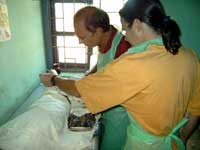 The next day we assisted him in his clinic when he sterilized a German shepherd dog. Somehow he seemed to know exactly which bits he had to cut away from the pile of bloody chicken filet that came blubbering out of the dog's belly. We held tongs, dipped some blood and made sure the dog did not wake up from its anaesthesia.
The next day we assisted him in his clinic when he sterilized a German shepherd dog. Somehow he seemed to know exactly which bits he had to cut away from the pile of bloody chicken filet that came blubbering out of the dog's belly. We held tongs, dipped some blood and made sure the dog did not wake up from its anaesthesia.
In one of the beach resorts in Mandrem we met Louis and Daniella, a British couple that drove overland from London to Sydney in a Landrover 6 years ago. They set up a bar in Mandrem, but had to return to London for family reasons and had sold their bar just that day. They are extremely nice and we spent a good deal of the next couple of days with them.
The evening before Coen's 30th birthday Gustavo and his family (mother, wife, 4 daughters, 3 puppies and one kitten) came for a BBQ at our place. The next morning they invited us for lunch and we had a swim together, to celebrate Coen's birthday. Louis and Daniella had invited us for a luxurious afternoon in the most expensive hotel of Goa, where they had taken a room for their last days in India. At night they took us out for dinner, again to celebrate Coen's birthday. Thanks a lot guys! It is a pity we did not have more time to spend together, but we will definitely keep in touch.
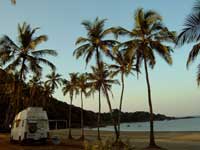 Via Panjim we went further south to Agonda, the overlander-beach in the south of Goa. A fantastic beach in a little bay of Bounty commercial calibre. We parked our van under the coconut palms at the beach side, hung up our newly bought hammock and intended to do nothing for at least two weeks.
Via Panjim we went further south to Agonda, the overlander-beach in the south of Goa. A fantastic beach in a little bay of Bounty commercial calibre. We parked our van under the coconut palms at the beach side, hung up our newly bought hammock and intended to do nothing for at least two weeks.
Every now and then a Goan climbs into the palm trees and cuts the coconuts. If we ask he will cut two extra and there we are: lying in our hammock, watching the sun set over the sea, drinking milk from the coconut or mixing a pinha colada. Fishermen walk by and sell freshly caught fish, that we grill on our BBQ. If we need something we take the small scooter we rented, put the dogs between us on the saddle and drive to the nearest town to do groceries. No problem in India. Tomorrow and the day after tomorrow we will celebrate a Christmas quite different from any Christmas we have had before.
We wish all of you merry Christmas and a happy 2004!
Dorrit
Part 2: Central India (25.12.03 - 14.02.04)
Written by: Coen
It has been a while but we don't want to hold back our further adventures in India and Nepal.
We have spent the Christmas days in magnificent Goa where we still occupied our nice spot on the beach between the palm trees. We were very busy grilling tiger prawns and sardines, swimming, lying in the hammock and walking on the beach.
Celebrating new years eve we did with some other travellers with a bbq and campfire on the beach.
After 3 weeks of holiday we decided to continue our trip but first we went to Panjim to say goodbye to Gustavo and his family and to see more of this beautiful Portuguese town. Together with the whole family do Pinto we made a round along the churches and cathedrals of the medieval city Veilha Goa (old Goa) and we enjoyed the Portugese flair with its white buildings standing out against the blue sky.
With a beer and CNN on the background, where Indian PM Vajpayee and Pakistan PM Musharaf shook hands for the first time in years, we said goodbye to Gustavo and Goa.
Through the interior of Goa, hills of forest and jungle, we drove to Londa. It was warm, green and moist when we drove on Indians roads again. Sometimes full of holes, sometimes sandy tracks but we fight our way through. We had almost forgotten how crazy the Indian traffic was. We were rewarded with fantastic views over grain fields, rice field terraces, hills with forest and termite hills that looked like miniatures of Saurons castle in Mordor.
In the rural villages, the inhabitants live in clay and straw houses and all the work is done by oxen. We spend the night on a truck parking along the road between masses of Tata trucks. Around 5 am the night watcher wakes us and we move together with a convoy of trucks. At the end of the day we were in Hampi where we spent 4 days in a nice resort.
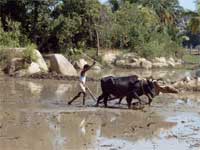 Hampi used to be the capital of a huge southern Indian empire about 600 years ago. It is situated in an kilometres large area full of rocks. Between de piles of huge stones you find centuries-old temples so we walked a lot between the villages and temples where children are playing between the chicken or are squatting down to answer nature's call and where big stray dogs react allergically on our dogs. After a few luxury days in the resort with good food and movie nights, we continued to drive to the moslim city Bijapur.
Hampi used to be the capital of a huge southern Indian empire about 600 years ago. It is situated in an kilometres large area full of rocks. Between de piles of huge stones you find centuries-old temples so we walked a lot between the villages and temples where children are playing between the chicken or are squatting down to answer nature's call and where big stray dogs react allergically on our dogs. After a few luxury days in the resort with good food and movie nights, we continued to drive to the moslim city Bijapur.
Via the sultan's tomb in Bijapur we drove to the temple caves in Ellora. These were very impressive and we needed 3 days to stroll in and around the Buddhist, Hinduist and Jainist caves completely cut out of rocks and decorated with beautiful reliefs.
Because we wanted to see more temple caves, we drove to the Ajanta temples from Ellora. The Ajanta temples, dating from the 2nd century B.C., are cut out in a gorge wall and were even more impressive with Buddha statues and very detailed wall and ceiling paintings.
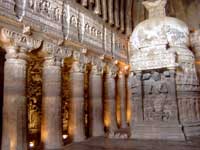 We left for Orchha and had to drive a few days. The road took us through the countryside of India where we only came forward very slowly because of bad roads and ox carriages. The roads are not old but because of the monsoon and the fact that the money for the fundaments disappear in somebody's pocket, the road is full of holes, deep pits and sometimes kilometres long no asphalt at all. Every 20 km we see crashed trucks or busses. The drivers chew on betel leaves all day long and this makes them invincible.
We left for Orchha and had to drive a few days. The road took us through the countryside of India where we only came forward very slowly because of bad roads and ox carriages. The roads are not old but because of the monsoon and the fact that the money for the fundaments disappear in somebody's pocket, the road is full of holes, deep pits and sometimes kilometres long no asphalt at all. Every 20 km we see crashed trucks or busses. The drivers chew on betel leaves all day long and this makes them invincible.
Along the road we see a lot of Indian Sadhu's (Hindu priests who have abandoned all connections to worldly goods) dressed in a piece of cloth and an orange turban with long beards and painted faces. We even see groups of Jain priests who walk around completely naked carrying a little broom to sweep away the ants they might step on otherwise.
In Indore we drove along the endless slum areas made of street litter where thin, dirty children and adults sit around their stoves.
On a field we discovered Uwe and Bettina from Berlin with their VW LT camper van (we already met in Goa). The rest of the day we drink tea and chat while the unavoidable crowd of staring Indians are squatting around us in a circle.
The next day we drove to Orchha for a tour along the magnificent castles and palaces of the old Rajput kingdom. Beautiful courtyards surrounded by innumerable towers, windows and balconies. In the not yet restaurated palaces we ascent and descent stairs through the labyrinth of chambers and halls for hours on end. The authentic market and the panorama over Orchha with its castle towers and roofs were splendid. Can it be more interesting? Well, some say it can; the porn temples of Khajuraho...
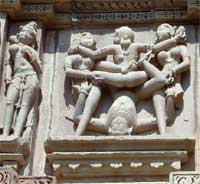 Here we spent 3 days visiting the temples, doing some maintenance on the car and walking through the area.
The temples in this enormous temple complex are on both the inside and the outside completely covered with humans, animals and gods in a variety of war actions and poses and here and there in Kamasutra actions. For the Indians, usually a very prude and conservative people, this is a real treat... It is said that when the British discovered these overgrown temples in the jungle, they were so shocked that they covered the place up again and kept silent about it at first.
Here we spent 3 days visiting the temples, doing some maintenance on the car and walking through the area.
The temples in this enormous temple complex are on both the inside and the outside completely covered with humans, animals and gods in a variety of war actions and poses and here and there in Kamasutra actions. For the Indians, usually a very prude and conservative people, this is a real treat... It is said that when the British discovered these overgrown temples in the jungle, they were so shocked that they covered the place up again and kept silent about it at first.
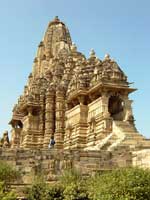 From Khajuraho we drove to Varanasi in 2 days. Via country roads we drove from village to village with irritating self-made barriers of people asking for road toll. There were no official pricelists or receipts. When we refused to pay 20 EURO at one of the barriers, the car was being surrounded by a group of young men. An rich Indian helped us escape from the situation. The trip went through spacious grass and swamp fields with white herons and pelicans. This is the poorest province in India and it shows. Only small villages with clay houses and poor people. Near Allahabad we drove along tents for kilometres on end for the more than 15 million pilgrims who come here for a dive in the Ganges every year.
From Khajuraho we drove to Varanasi in 2 days. Via country roads we drove from village to village with irritating self-made barriers of people asking for road toll. There were no official pricelists or receipts. When we refused to pay 20 EURO at one of the barriers, the car was being surrounded by a group of young men. An rich Indian helped us escape from the situation. The trip went through spacious grass and swamp fields with white herons and pelicans. This is the poorest province in India and it shows. Only small villages with clay houses and poor people. Near Allahabad we drove along tents for kilometres on end for the more than 15 million pilgrims who come here for a dive in the Ganges every year.
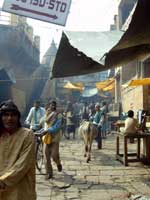 On a piece of land behind an expensive hotel in Varanasi we could camp. We stayed 6 days in Varanasi because it turned out to be such an impressive city. In the hotel we were staying they organized big weddings so we were lucky to attend two big Indian weddings. With Fatima and Mario from Tuebingen (Germany) we visited the Ghats, the washing stairs along the Ganges. In the holiest city of the Hindus, the 7 km long western shores of the Ganges exist of meters high and broad stone stairs leading from the old city into the water of the Ganges. On these stairs people wash, pray, sing and hundreds of pilgrims take a bath in the heavily contaminated water. 10 meters away from where the Hindus are taking a bath and are even drinking the water, the litter from the city mixed with cremation waste and swollen dog bodies float around.
On a piece of land behind an expensive hotel in Varanasi we could camp. We stayed 6 days in Varanasi because it turned out to be such an impressive city. In the hotel we were staying they organized big weddings so we were lucky to attend two big Indian weddings. With Fatima and Mario from Tuebingen (Germany) we visited the Ghats, the washing stairs along the Ganges. In the holiest city of the Hindus, the 7 km long western shores of the Ganges exist of meters high and broad stone stairs leading from the old city into the water of the Ganges. On these stairs people wash, pray, sing and hundreds of pilgrims take a bath in the heavily contaminated water. 10 meters away from where the Hindus are taking a bath and are even drinking the water, the litter from the city mixed with cremation waste and swollen dog bodies float around.
More than 100 persons a day are being cremated on big funeral pyres and their ashes are scattered in the Ganges. Children, Sadhu's and lepers are not cremated but are donated directly to the Ganges. Luckily we did not see their bodies floating by!
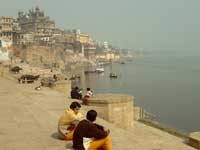 After visiting the burning Ghats, we patted the ashes from our clothes and although they use aromatic wood for the burnings, the smell of burning flesh, hairs and nails sticks in your nose for the rest of the day.
After visiting the burning Ghats, we patted the ashes from our clothes and although they use aromatic wood for the burnings, the smell of burning flesh, hairs and nails sticks in your nose for the rest of the day.
The other days we rented a boat for a sunrise tour on the Ganges with a beautiful view over the city shore; we visited a few of the many Maharaja palaces built for the Maharaja's who were to be cremated here and we strolled through the 1,5 meters broad streets of the old city. We had to share the narrow space with cows and pass small dark streets where all sorts of handicrafts were practised and we enjoyed the innumerable small temples and holy objects in the old city. Then it is time to leave Varanasi and India.
After almost 4 months in India where everything is very overwhelming, we are ready for a less densely populated country. For us India was a fantastic experience with friendly and sincere people and a splendid kitchen. What else do you want!
Coen
|
 |
|
 |
 |
 |
 |
Our top 8: |
 |
 |
1. Goa
2. Jodhpur
3. Varanasi
4. Kulu
5. Amritsar
6. Ajanta
7. Orchha
8. Hampi
|
 |
 |
 |
 |
 |
 |
 |
 |
TIP |
 |
 |
Visa: you can get a 6 month tourist visa for India for USD 55 in Ankara (Turkey) within two weeks.
However, this is always from date of issue, never from date of entry!!
|
 |
 |
 |
 |
 |
 |
 |
 |
TIP: |
 |
 |
In Amritsar you can park at Bandhari's guesthouse in the 10th cantonment. Quite expensive at EUR 10, but very nice.
|
 |
 |
 |
 |
 |
 |
 |
 |
TIP: |
 |
 |
All over Rajasthan you can camp at the RTDC-hotels for 150 rupees (EUR 3) per night. These state hotels are usually near the centre and have beautiful gardens where you can park your camper van.
|
 |
 |
 |
 |
 |
 |
 |
 |
TIP: |
 |
 |
In the Kulu valley, just north of Mandi, you will find a beautiful place to camp in the garden of the Dear and Dear hotel. You will have to eat there, but the food is good and cheap.
|
 |
 |
 |
 |
 |
 |
 |
 |
TIP: |
 |
 |
None of the campings in Delhi are open anymore!!
|
 |
 |
 |
 |
 |
 |
 |
 |
TIP: |
 |
 |
Restaurant Ambrai in Udaipur offers good food in a romantic garden with view over the city palace, the lake and its two islands.
|
 |
 |
 |
 |
 |
 |
 |
 |
TIP: |
 |
 |
Places to stay for campers in Middle India:
Hampi:
Free of charge at the Mowgli-resort, as long as you eat there.
Ellora:
Free of charge at the MTDC, as long as you eat there.
Ajanta:
Cheap at the MTDC.
Khajuraho:
In the state hotel Payal (UTDC) for 25 Rs (EUR 0,50).
Varanasi:
At hotel De Paris in Cantt. for 150 Rs (EUR 3)
At hotel Surya in Cantt. for 150 Rs (EUR 3)
|
 |
 |
 |
 |
 |
 |
 |
 |
TIP: |
 |
 |
From Khajuraho to Varanasi you'd best take the road via Banda, Mau and Allahabad.
|
 |
 |
 |
 |
 |
 |
 |
 |
TIP: |
 |
 |
The fastest internet connection of India can be found in Varanasi at hotel Surya in Cantt.
|
 |
 |
 |
 |
 |
 |
 |
 |
TIP: |
 |
 |
Rest. Napoli in Cantt., Varanasi, behind hotel Radisson has great food and a lovely Italian atmosphere.
|
 |
 |
 |
 |
 |
 |
|


